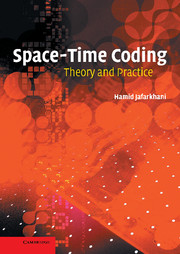Book contents
- Frontmatter
- Contents
- Preface
- Standard notation
- Space-time coding notation
- List of abbreviations
- 1 Introduction
- 2 Capacity of multiple-input multiple-output channels
- 3 Space-time code design criteria
- 4 Orthogonal space-time block codes
- 5 Quasi-orthogonal space-time block codes
- 6 Space-time trellis codes
- 7 Super-orthogonal space-time trellis codes
- 8 Differential space-time modulation
- 9 Spatial multiplexing and receiver design
- 10 Non-orthogonal space-time block codes
- 11 Additional topics in space-time coding
- References
- Index
7 - Super-orthogonal space-time trellis codes
Published online by Cambridge University Press: 14 August 2009
- Frontmatter
- Contents
- Preface
- Standard notation
- Space-time coding notation
- List of abbreviations
- 1 Introduction
- 2 Capacity of multiple-input multiple-output channels
- 3 Space-time code design criteria
- 4 Orthogonal space-time block codes
- 5 Quasi-orthogonal space-time block codes
- 6 Space-time trellis codes
- 7 Super-orthogonal space-time trellis codes
- 8 Differential space-time modulation
- 9 Spatial multiplexing and receiver design
- 10 Non-orthogonal space-time block codes
- 11 Additional topics in space-time coding
- References
- Index
Summary
Motivation
STBCs provide full diversity and small decoding complexity. STBCs can be considered as modulation schemes for multiple transmit antennas and as such do not provide coding gains. As we discussed earlier in Chapters 4 and 5, full rate STBCs do not exist for every possible number of transmit antennas. On the other hand, STTCs are designed to achieve full diversity and high coding gains while requiring a higher decoding complexity. The STTCs presented in Chapter 6 are designed either manually or by computer search. In this chapter, we provide a systematic method to design space-time trellis codes.
Another way of achieving high coding gains is to concatenate an outer trellis code that has been designed for the AWGN channel with a STBC. Let us view each of the possible orthogonal matrices generated by a STBC as a point in a high dimensional space. The outer trellis code's task is to select one of these high dimensional signal points to be transmitted based on the current state and the input bits. In [5], it is shown that for the slow fading channel, the trellis code should be based on the set partitioning concepts of “Ungerboeck codes” for the AWGN channel.
The main idea behind super-orthogonal space-time trellis codes (SOSTTCs) is to consider STBCs as modulation schemes for multiple transmit antennas. We assign a STBC with specific constellation symbols to transitions originating from a state.
- Type
- Chapter
- Information
- Space-Time CodingTheory and Practice, pp. 151 - 194Publisher: Cambridge University PressPrint publication year: 2005



